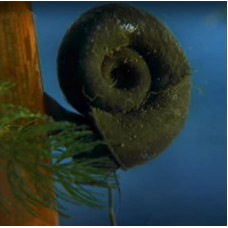A type of secondary invertebrate. Probably originated in the Precambrian; several classes of molluscs are known from the Lower Cambrian. Probably descended from small-segmented worm-like ancestors or directly from ciliated worms. The original bilateral symmetry of molluscs can be broken secondarily (especially in gastropods). The body consists of an unsegmented trunk (only some primitive molluscs show signs of metamerism),
A head with a mouth opening, tentacles and often eyes; sometimes partially or completely reduced (also in bivalves). The leg is more often on the ventral side of the body (used for crawling), in swimming species the leg has lateral extensions, in some species it is reduced. The body (internal sac) is covered by a fold of skin - the mantle - and in many molluscs it is surrounded by a shell made of a substance secreted by the outer surface of the mantle. The shell may consist of eight plates (bivalve molluscs), two lateral flaps or a single piece; it provides protection and support (external skeleton). The shell may be underdeveloped (e.g. in some bivalves) or absent (e.g. in Aplacophora).
Between the mantle and the trunk, in the mantle cavity, are the respiratory organs and some sensory organs, it opens the external orifices of the genital and excretory organs, the anus. The intestine. In its anterior section exit ducts of salivary glands, on the surface of the muscular tongue is radula (grater) - a plate with transverse rows of teeth (sometimes up to 500). In some gastropods and cephalopods it may be partially or completely absent. In the middle part of the intestine is the stomach and the place of confluence of the ducts, usually a paired digestive gland (similar to the liver).
Respiratory organs serve as primary gills - ctenidia, in land molluscs a modified mantle cavity serves as lungs. The circulatory system is not closed; the heart consists of a ventricle and 1-4 (more often 2) atria.
The excretory organs are paired kidneys.
The nervous system in primitive molluscs consists of the oculoglossal nerve ring and 4 longitudinal nerve trunks, on which several pairs of ganglia are formed in higher molluscs.
All molluscs are divided into 2 subgroups: bivalves (aplacophores and clams) and molluscs (gastropods, cephalopods, bivalves, clams, monoplacophores). 130 (according to other data 150) thousand modern species and about 50 thousand extinct species, including ammonites, belemnites, rudists, chiolites. They are distributed all over the world. Most of them live in the sea (many in the coastal zone of tropical seas), a relatively small number of species - in brackish and fresh waters. On land they are found from the tundra to the tropics. Freshwater molluscs live mainly near the bottom. Because of this lifestyle, they have evolved a variety of life forms and adaptations; among molluscs there are swarming, attached and crawling forms; detritophagous, predatory and necrophagous, often plant or omnivorous scrapers.
Reproduction is sexual, there are separate sexes and simultaneous hermaphrodites. Fertilisation is external (in primitive forms) or internal (in higher forms). Separate sex molluscs are often characterised by sexual dimorphism. The fertilised egg gives rise to either a larva (trochophora, veliger) or an adult mollusc. Larvae are usually free-swimming, but in some species they pass through the stage of parasitisation on fish. In cephalopods and some gastropods, mating is preceded by a complex courtship ritual. The life span of a mollusc ranges from a few months to several decades. Aquatic molluscs often dominate benthic communities. Molluscs form part of the diet of invertebrates, fish and some cetaceans. Many species of snails (especially freshwater and terrestrial) are intermediate hosts for parasitic worms.
Molluscs
Tags: mollusks






